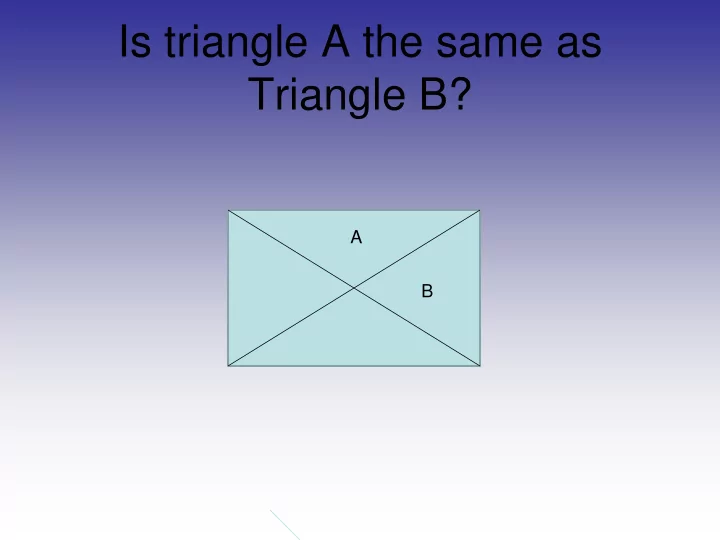

Is triangle A the same as Triangle B? A B
Mathematics at Bathwick St. Mary Primary School AIMS • To inform you about the Maths national curriculum • To tell you about Maths learning and progression at School • To show you ideas for helping at home with Maths
Years 1-6 Aims of the new curriculum for KS1 and KS2: - To become fluent in the fundamentals of mathematics and to be able to recall and apply knowledge rapidly and accurately - To reason mathematically - To solve problems by applying knowledge • There is an expectation that children will master specific targets by the end of each year.
What is covered at KS1? • Numbers- place value, addition, subtraction, multiplication and division • Fractions • Measurements • geometry – positions, directions and shapes • statistics .
Targets to be met at the end of each year: e.g. Year 1 Year 2 • count to and across 100, • count in steps of 2,3,5,10 • use number bonds to 20, forwards and backwards, • Solve simple multiplication • add and subtract 2 digit and division problems numbers, through grouping or sharing • recognise ½, ¼ , • know 2x, 5x, 10x tables, • measure length, weight, • find ½ ¼ ¾ of a shape or capacity, number, • tell time to hour and half • use money, past, • name 2-d and 3-d shapes, • tell the time to 5 minutes, • describe ¼ ½ and ¾ turns. • recognise symmetry, • construct tally charts and compare data
The Daily Lesson from Years 1-6 • Mental starter • Main Introduction and Group Activity • Independent/Group Activity • Plenary
Learning styles • VISUAL • AUDITORY • ACTIONS • MENTAL • WRITTEN • Grouped/paired • individual
Written Calculations at Bathwick subtraction addition division multiplication Essential to have number knowledge: bonds and times tables
Addition 1. Hands on addition 2. Pictorial addition/100square 3. The empty number line 2. Partitioning 3. Expanded method in columns 4. Column addition
Hands on and pictorial addition • How can you make 5 using unifix? • Put in hands- what happens if you swap your hands over. Do you still have 5?
The empty number line
Partitioning • 47+76 = 40+70+7+6=110+13=123 • 47 = 40 + 7 • +76 = 70 + 6 • 110 + 13 = 123
Subtraction 1. Hands on subtraction 2. Pictorial subtraction/100square 3. Using the empty number line 4. Partitioning 5. Expanded method 6. Column subtraction
The empty number line- counting up • 25- 13 +5 + 7 • 13 20 25 • So 25-13 = 7+5 = 12
Partitioning • Subtraction can be recorded using partitioning: • 74 - 27 = 74 - 20 - 7 = 54 - 7 = 47
Multiplication 1. Hands on/ groups of 2. Pictorial/groups of 3. Jottings with arrays 4. Number line 5. Mental multiplication using partitioning 6. Grid method 7. Column multiplication
Arrays 3 x 5 5 x 3 Links to vocabulary
Mental multiplication using partitioning By the end of year 2 children are expected to know their 2x, 5x, 10x tables up to 12 x10 off by heart and be able to use a times table square to help with others.
Division 1. Sharing and grouping using objects 2. Jottings on pictures/number line 3. Empty number line 4. Mental division using partitioning 5. Expanded method for HTU (Chunking) 6. Short division 7. long division
grouping • 6 divided by 2 = • 2 lots of 3
The empty number line
Mental division using partitioning By the end of year 2 children are expected to know the related division facts for 2x, 5x and 10x tables off by heart .
TESTS KS1 • 1 arithmetic test (15minutes on number only) • 1 test for mathematical fluency, solving problems and reasoning (35minutes on number, shapes, measures and statistics) • Levels are not given. It is achieved or not achieved. • There will be a SATS talk closer to the time.
How you can help at home. • Crucial that children practice times tables and number bonds. • Look for number in everyday activities. Make Maths fun to do… Play games: snakes and ladders, darts, dominoes and other games that depend on numbers, counting, calculation and scoring. Do some cooking. Use timers and clocks .
How you can help at home… • POCKET MONEY . Help them to add it up week by week, and work out whether they can afford a particular toy or treat. Shop using money and calculate change. TIME . Look at clocks, both digital and analogue. Estimate how long a certain activity will take to do and see if you are right! Work out how long it is until the next mealtime. Play games: how long is a minute, starting from now? • HOBBIES . If your child is car-mad, talk about relative engine sizes, fuel economy, speed and performance. Watch and play sports that involve scoring, timing, counting, measuring. CALENDARS AND DATES . Give your child a calendar to record special occasions. Count the days in each month. Learn the poem 30days hath September etc.
Creating a maths mind! • Don’t say ‘I am no good at maths’ – a good role model is very important, especially for girls. • It is ok to make mistakes. • Children who can manipulate their fingers without looking, do better at maths. (show bunny ears) • Find the links to numbers in different ways. E.g. 5 can be shown in many different ways. Eg, on a dice, on cards , roman numerals, 4+1, with unifix. • Ask questions about numbers.
Parent Booklets • There is a parent booklet available for each year group with some targets, questions and activities that you can refer to. • It includes calculation progressions for addition, multiplication, subtraction and division. • It will be sent home with your child!
Recommend
More recommend